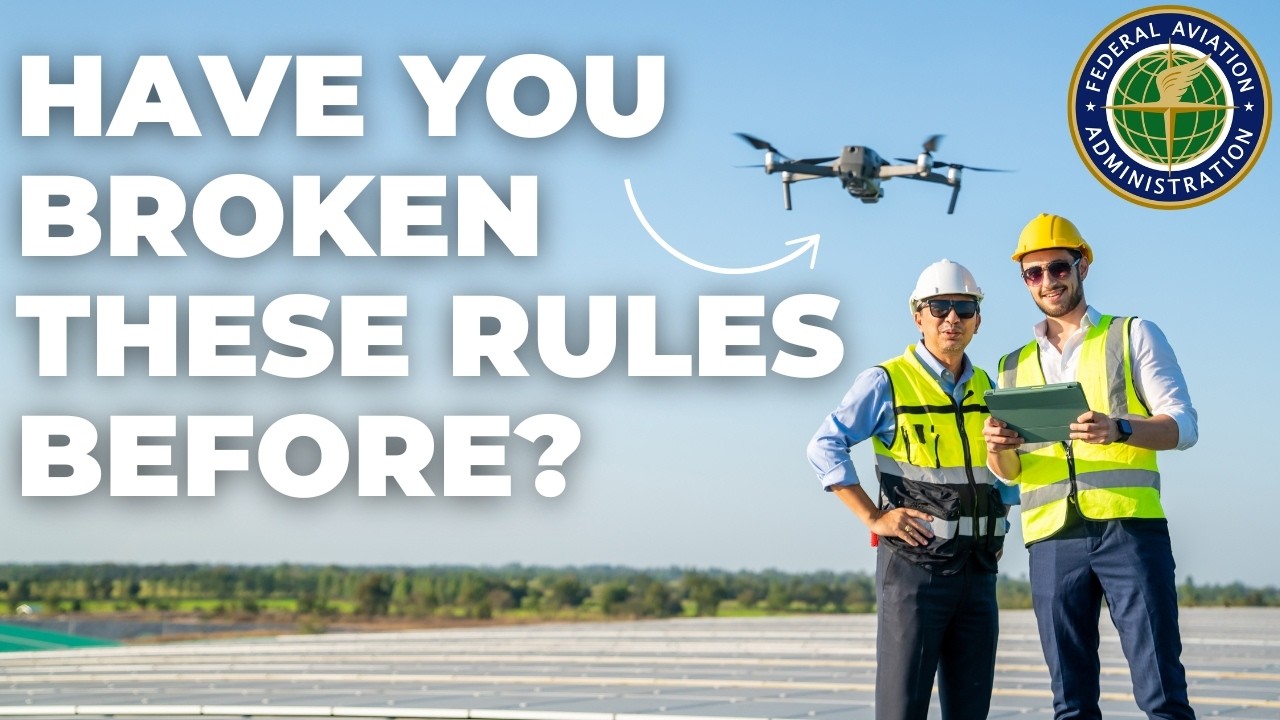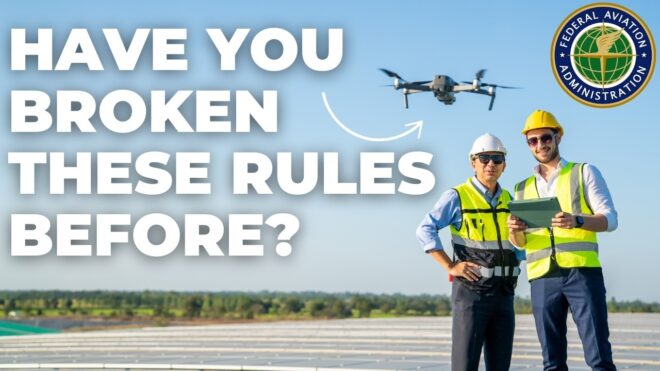You’re in for a treat as we explore some common FAA drone rules that many might inadvertently overlook. It’s easy to slip up when flying your drone, but ensuring you know and follow these rules can help you stay on the right side of the law. The video by UAV Coach reveals five regulations that often trip up both recreational and commercial pilots. Rest assured, all is not lost if you’ve made a mistake—many of these can be easily fixed once you’re aware of them.
The video will guide you through navigating these frequently misunderstood rules, with useful advice on staying compliant. Whether it’s keeping your drone within sight or understanding the necessity of a TRUST certificate, UAV Coach breaks down each aspect clearly. You’ll learn about flying over people or vehicles and what it means when you’re in controlled airspace. So, gear up for important insights that promise to enhance your flying experience safely and legally, ensuring you’re always ahead of the game in the US drone landscape.

Understanding FAA Drone Regulations
As a drone enthusiast or professional pilot, it’s essential to grasp the intricacies of the Federal Aviation Administration (FAA) drone regulations. By doing so, you ensure safe flying practices and avoid potentially costly legal missteps. Let’s delve into why these regulations exist and who needs to adhere to them.
Why FAA Regulations Exist
FAA regulations are in place primarily to maintain safety in the skies and on the ground. Drones, while innovative and useful, can pose significant risks if not operated responsibly. These rules exist to mitigate the chances of accidents, protect privacy, and ensure national security. Moreover, they facilitate the integration of drones into the national airspace without disrupting manned aviation activities. By complying, you contribute to a safer environment and foster public trust in drone technology.
Who Needs to Comply with These Regulations
Whether you’re an amateur flyer enjoying drones as a hobby or a part of a commercial operation, FAA regulations apply to you. Recreational pilots must adhere to basic safety guidelines, including registering their drone if it weighs over 0.55 pounds. Conversely, commercial pilots require the FAA’s Part 107 certification to fly. Regardless of your flying intentions, understanding and abiding by these rules ensures you operate legally and safely.
Flying Beyond Visual Line of Sight (BVLOS)
Flying beyond visual line of sight (BVLOS) is a regulatory area that’s often misunderstood but incredibly important.
Definition of Visual Line of Sight
Visual line of sight (VLOS) means keeping the drone within your visual range without relying on additional visual aids, excluding corrective eyewear. Essentially, you should be able to see your drone with your eyes unaided to make immediate and informed flight decisions to avoid hazards.
Risks and Legal Implications of BVLOS
Flying BVLOS increases the likelihood of losing control or colliding with obstacles due to reduced situational awareness. Legally, doing so without proper authorization is a violation of FAA regulations, which could lead to penalties, fines, or even license revocation for commercial operators. Therefore, maintaining VLOS is crucial to minimizing risk and ensuring compliance.
How to Avoid Breaking This Rule
Avoiding the breach of this rule is straightforward: always ensure your drone remains within sight. If you’re a commercial operator needing to fly BVLOS, you must apply for a special waiver. Regularly scanning the sky during flights ensures you retain control and comply with FAA mandates.
Flying Recreationally Without TRUST Certification
What is TRUST?
The Recreational Unmanned Aircraft Systems Safety Test, or TRUST, is a required educational course for all recreational drone pilots. It equips you with essential knowledge about safe flying practices and current regulations.
The Process of Obtaining a TRUST Certification
Obtaining TRUST certification is a simple process. You can complete free online training that covers key safety and regulatory concepts, followed by a short test. Upon passing, you receive certification, allowing you to fly drones recreationally in U.S. airspace legally.
Consequences of Flying Without TRUST
Flying without TRUST certification is illegal and can result in serious repercussions, including fines or confiscation of your drone. Therefore, it’s vital to secure this certification to prevent legal issues and demonstrate your commitment to responsible flying.
Flying Over People Without Proper Authorization
Overview of Drone Categories for Flying Over People
The FAA classifies drones into various categories to establish which can fly over people. Category 1 drones weigh less than 0.55 pounds and include protective safeguards. Categories 2 and 3 have different safety thresholds and operational restrictions, usually requiring manufacturers’ declarations of compliance or additional FAA waivers.
Exceptions to the Rule
You can fly over people in specific scenarios—such as emergency response or if people are under a covered structure that provides adequate protection. Keep in mind, however, these are exceptions, not the rule, and generally involve additional safety measures.
How to Obtain a Waiver for Flying Over People
For operations involving larger drones or those not automatically compliant, applying for a waiver through the FAA’s DroneZone is necessary. This process involves demonstrating comprehensive risk assessments and safety plans to ensure public safety during your drone’s operations.
Operating a Drone From a Moving Vehicle
FAA Restrictions on Moving Vehicle Operations
FAA regulations generally prohibit operating drones from moving vehicles unless in sparsely populated areas and not transporting property for compensation. This restriction ensures full focus on drone operation without the distractions associated with vehicular movement.
Understanding Waiver Opportunities
While restrictions are in place, waivers offer a means to expand operational capabilities legally. For commercial operations needing to work from moving vehicles, applying for a waiver through the FAA could grant you the opportunity after demonstrating safe operating procedures.
Guidelines for Safe Operations in Sparsely Populated Areas
When operating in less populated regions, you must still follow FAA guidelines, maintaining visual line of sight and avoiding flying over people or moving vehicles. Adequate preparation and vigilant monitoring of your surroundings are crucial to ensure safety and compliance.
Flying Over or Near Moving Vehicles
Regulations for Flying Over Highways and Roads
Flying drones over highways and moving vehicles is restricted to prevent accidents and disruptions. The presence of fast-moving traffic can increase the risk of a drone crashing or causing an accident if it fails.
Category 1 Drone Requirements
Category 1 drones, lightweight and equipped with proper safeguards, may fly briefly over moving vehicles as long as they comply with specific FAA requirements. However, these operations must be quick and safe, ideally with mitigation measures in place.
Applying for Waivers to Fly Over Vehicles
To conduct more extensive operations, applying for an FAA waiver is necessary. This involves a comprehensive understanding of operation risks and demonstrating that safety measures are adequate. These waivers facilitate commercial operations, such as filming where flying over roads is essential.
Controlled Airspace Operations Without Authorization
Classifying Airspace: What You Need to Know
Controlled airspace includes Class B, C, D, and E airspaces surrounding airports where higher air traffic densities exist. Each class has specific procedures and rules that any drone operator must understand and respect before flight.
The Process of Obtaining FAA Authorization
Authorization to fly in controlled airspace is easily accessible through the Low Altitude Authorization and Notification Capability (LAANC) system, which permits rapid approval for certain locations. By using LAANC-approved applications, you can apply and often receive near-instantaneous permission.
Benefits of Legal Compliance in Controlled Airspace
Operating legally within controlled airspace not only ensures compliance but also strengthens the safety and reliability of national airspace. It helps avoid expensive fines and supports smoother integration of drones in complex environments, benefiting all airspace users.
Common Misunderstandings About Drone Rules
Misinterpretations of Visual Line of Sight
A common misunderstanding is that augmentative devices like cameras or binoculars suffice for maintaining line of sight, which the FAA strictly prohibits. Only corrective glasses are allowed to ensure clear and direct awareness of the drone.
Assumptions About Recreational Flying
Some assume recreational flying lacks stringent rules, leading to casual attitudes toward safety and regulation adherence. However, even recreational pilots must follow specific regulations to avoid legal complications and safety risks.
Overestimating Remote Locations
Another fallacy is believing remote or rural locations exempt pilots from FAA rules, assuming reduced risk. However, FAA regulations apply universally in U.S. airspace, emphasizing legal compliance regardless of location.
Resources for Drone Pilots
Online Educational Tools and Courses
Numerous online platforms offer drone education resources, such as UAV Coach and its comprehensive course offerings. These resources are invaluable for both newcomers and experienced pilots, enabling ongoing learning and skill enhancement.
Recommended Apps for FAA Compliance
Apps like Airmap and Kittyhawk provide essential data for flight planning, such as airspace classifications, local advisories, and LAANC processes. Utilizing these tools helps maintain adherence to all FAA regulations, ensuring safe and legal operations.
Where to Find the Latest FAA Updates
Staying informed is vital, and the FAA’s dedicated drone website provides timely updates and regulatory changes. Regularly checking this resource ensures you’re aware of any developments affecting your flying practices.
Conclusion
Summary of Key Points
Understanding and adhering to FAA drone regulations is crucial for safe and enjoyable flying. From maintaining visual line of sight to ensuring TRUST certification and obtaining necessary waivers, these rules support safety, legality, and responsibility in drone operations.
Encouragement for Responsible Drone Usage
Safe, responsible drone usage helps protect your rights as a pilot while promoting public trust and enthusiasm in drone technology. By operating within the FAA’s framework, you contribute to a positive environment where the drone industry can flourish.
Resources for Continued Learning and Compliance
Commit to continuous learning by accessing reliable educational platforms, utilizing available apps for compliance, and keeping abreast of FAA updates. These practices not only enhance your skills but also help you maintain compliance, allowing for safe, legal, and enjoyable drone experiences.

